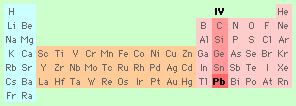 Background
information
Background
information Background
information
Background
informationLead (Pb) is in group 4 of the Periodic Table.
The major man made source of lead in the environment is emissions from the combustion of leaded petrol.
Lead (in the form of tetraethyllead, Pb(CH2CH3)4), is added to petrol to allow engines to run at higher compression ratios (which are more fuel-efficient and produce greater power) without 'knocking' (premature ignition).
Various organo-chlorine and bromine compounds (most notably dichloroethane, CH2Cl-CH2Cl, and dibromoethane, CH2Br-CH2Br) are also added to petrol to allow the used lead to be flushed out of the engine in the form of volatile lead halides (most notably lead bromochloride, PbBrCl). On cooling, the resulting aerosol usually has particles of diameters less than 2 microns (2 * 10-6 m) which can easily pass into the lungs where the lead can be metabolised.
Some lead enters the environment from
Human exposure to lead arises from four main sources
Lead undergoes comaparatively little chemical alteration once in the environment, the vast majority of lead being in the form of aqueous Pb2+ ions or insoluble lead(II) compounds.
Physical changes in the environment mainly involve precipitation and dissolution depending on the ambient conditions.
Lead binds strongly to many enzymes and proteins (including haemoglobin) as well as to RNA and DNA resulting in the disruption of many metabolic pathways.
Lead is a cumulative poison. The residence time in blood and soft tissues is about a month, but the residence time in bones is of the order of 50 years. Lead immobilised in bones can subsequently be remobilised during illness, cortisone treatment or old age.
Symptoms of lead poisoning include